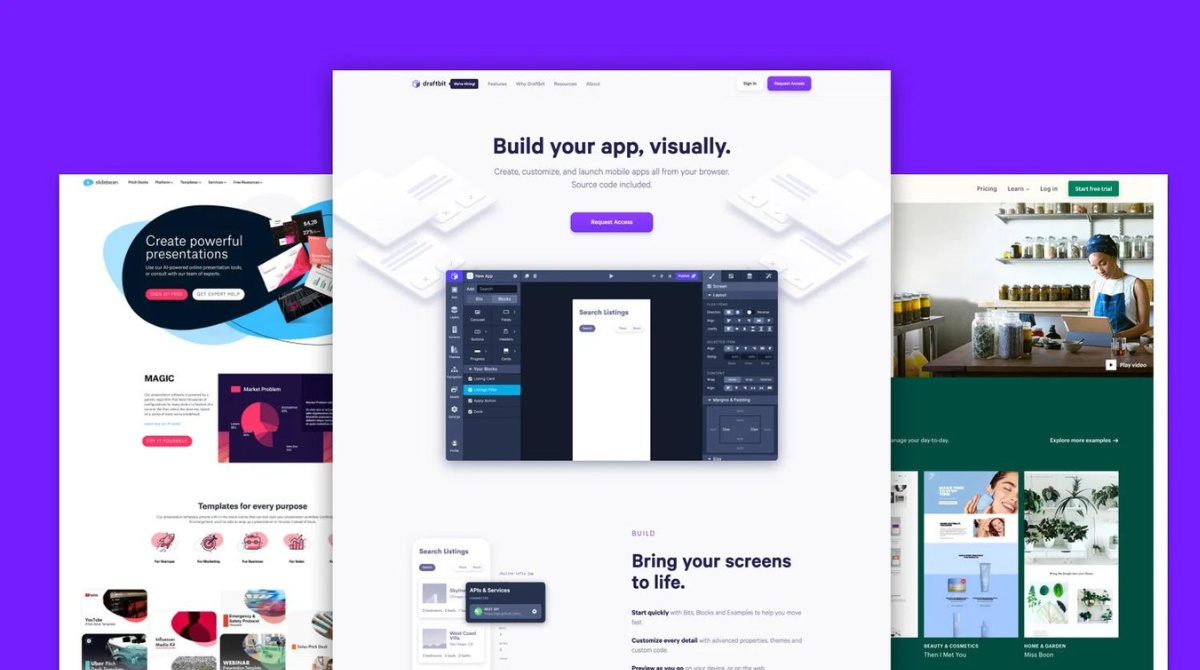Introduction
Welcome to the world of Software as a Service (SaaS)! As the digital landscape continues to evolve, the SaaS industry has become increasingly competitive. To stand out from the crowd and attract potential customers, it is crucial to create high-quality content that not only engages your target audience but also ranks well in search engine results.
In this article, we will delve into the various strategies and techniques you can implement to make your SaaS content rank higher. From understanding the SaaS industry and defining your target audience to optimizing your website and creating compelling content, we will guide you through each step of the process.
While there is no magic formula for instant success, by following the recommendations in this article, you will be equipped with the necessary tools to boost your SaaS content’s visibility in search engine rankings, drive organic traffic, and ultimately increase conversions.
Before we dive into the details, let’s take a moment to understand the SaaS industry and its unique characteristics. SaaS refers to the delivery of software applications over the internet, eliminating the need for users to download or install the software on their own devices. This model has gained tremendous popularity due to its scalability, cost-effectiveness, and ease of use.
However, with the increasing number of SaaS providers, it has become challenging for businesses to reach their target audience effectively. That’s where search engine optimization (SEO) comes into play. By optimizing your SaaS content for search engines, you can increase its visibility and reach a wider audience.
Throughout this article, we will explore the fundamental principles of SEO and how they can be applied to your SaaS content. From conducting keyword research and optimizing your website structure to crafting valuable and relevant content, we will cover everything you need to know to make your SaaS content stand out in the vast digital landscape.
So, if you’re ready to take your SaaS content to the next level and boost its ranking in search engine results, let’s dive in and explore the world of SEO for SaaS!
Understanding the SaaS Industry
Before diving into SEO strategies for SaaS content, it’s important to have a solid understanding of the SaaS industry itself. The SaaS model has revolutionized the way businesses and consumers access and use software applications. But what exactly sets it apart from traditional software delivery methods?
SaaS, short for Software as a Service, refers to the provision of software applications over the internet. Unlike traditional software, which requires installation and maintenance on individual devices, SaaS allows users to access and use applications through a web browser or dedicated client. This eliminates the need for costly infrastructure, updates, and system requirements, making it an attractive option for businesses of all sizes.
One of the key characteristics of the SaaS industry is its scalability. SaaS providers can easily accommodate the needs of growing businesses by offering flexible pricing plans and allowing customers to upgrade or downgrade their subscription as required. This scalability makes SaaS an ideal choice for startups and small businesses that want to minimize upfront costs and scale their operations over time.
Another advantage of the SaaS model is the continuous innovation and updates that come with it. Since software applications are hosted and maintained by the SaaS provider, they can release updates and new features seamlessly without any interruptions or inconveniences for the users. This ensures that businesses always have access to the latest technology and can stay competitive in their respective industries.
However, the rapid growth of the SaaS industry has also led to increased competition. With countless providers offering similar solutions, differentiating your SaaS product or service becomes crucial. This is where SEO plays a vital role.
By implementing effective SEO strategies, you can improve the visibility of your SaaS content and increase its chances of reaching your target audience. This involves optimizing your website structure, conducting keyword research, creating high-quality content, and building backlinks, among other techniques.
Understanding the unique aspects of the SaaS industry and how they impact your target audience’s needs and preferences is essential in developing an effective SEO strategy. By aligning your SEO efforts with the industry’s trends and requirements, you can gain a competitive edge and position your SaaS product or service for success.
In the next sections, we will explore the step-by-step process of optimizing your SaaS content for search engines. From defining your target audience and identifying relevant keywords to creating engaging content and promoting it through various channels, we will provide you with actionable tips and strategies to improve your SaaS content’s ranking.
Defining Your Target Audience
When it comes to creating successful SaaS content, defining your target audience is a crucial first step. Your target audience consists of the specific group of people who are most likely to benefit from your SaaS product or service. By understanding their needs, preferences, and pain points, you can tailor your content to resonate with them and increase the chances of conversion.
Start by conducting thorough market research to identify your target audience. Look at the demographics, such as age, gender, location, and occupation, as well as psychographics, including interests, behaviors, and motivations. This will help you create detailed buyer personas – fictional representations of your ideal customers.
Once you have your buyer personas in place, think about the challenges and pain points your target audience may be facing. How can your SaaS product or service provide a solution or value to them? Understanding their specific needs will enable you to craft content that speaks directly to them, positioning your SaaS as the answer to their problems.
It’s also essential to consider the stage of the buyer’s journey your target audience is in. Are they in the awareness stage, just becoming aware of the problem they have? Are they in the consideration stage, actively researching and comparing different solutions? Or are they in the decision stage, ready to make a purchase decision? Tailoring your content to each stage of the buyer’s journey will ensure you deliver the right message at the right time.
Furthermore, keep in mind that your target audience may comprise different segments or niches. Each segment may have unique characteristics and preferences. By understanding these nuances, you can create targeted content that resonates with each segment, increasing your chances of engagement and conversion.
Defining your target audience is not a one-time task. As your SaaS business evolves, you may need to revisit and update your buyer personas to reflect any changes in the market or customer preferences. Regularly monitoring and analyzing your audience’s behavior and feedback will help you stay adaptable and ensure your content remains relevant and effective.
By knowing exactly who your target audience is and what they need, you can produce content that speaks directly to them. This personalized approach will not only increase engagement but also improve your SEO efforts. When your content aligns with your audience’s search queries, search engines are more likely to recognize its relevance and rank it higher in search results.
In the next sections, we will explore how to identify relevant keywords, optimize your website structure, and create compelling content that resonates with your target audience. Let’s dive in and take your SaaS content to the next level!
Identifying Relevant Keywords
Keywords play a vital role in SEO, as they are the words and phrases that users enter into search engines when looking for information, products, or services. In order to make your SaaS content rank higher, you need to identify relevant keywords that are highly searched for by your target audience.
Start by brainstorming a list of keywords that are directly related to your SaaS product or service. Think about the terms your target audience would use when searching for solutions similar to what you offer. For example, if you provide project management software, relevant keywords could include “project management tool,” “task management software,” or “project planning app.”
Once you have a list of seed keywords, use keyword research tools such as Google Keyword Planner, SEMrush, or Moz Keyword Explorer to expand your list and find additional related keywords. These tools provide valuable insights into search volumes, competition levels, and related keywords, helping you identify the most relevant terms to target.
When conducting keyword research, it’s important to strike a balance between high search volumes and competition levels. While it may be tempting to target highly popular keywords with millions of monthly searches, it’s important to consider whether you can effectively compete with established players in the industry. Additionally, focusing on long-tail keywords – longer, more specific phrases – can help you target a more niche audience and increase your chances of ranking higher.
Once you have a comprehensive list of keywords, organize them into groups or clusters based on their relevance and intent. This will help you create targeted content for each keyword group and improve your chances of ranking well for multiple related terms.
Remember, SEO is not just about stuffing your content with keywords. It’s about creating valuable and relevant content that naturally incorporates keywords and provides the answers and solutions your target audience is searching for. Use keywords strategically in your content’s headings, subheadings, and throughout the body without sacrificing readability or user experience.
In addition to using keywords in your content, optimize other elements of your website, such as meta titles, descriptions, and URLs, to include relevant keywords. This helps search engines understand the context and relevance of your content, improving your chances of ranking higher.
Finally, regularly monitor and analyze your keyword performance to identify trends, opportunities, and areas for improvement. SEO is an ongoing process, and staying up-to-date with keyword research will help you adapt your content strategy accordingly.
By identifying relevant keywords and incorporating them strategically into your content, you can increase your SaaS content’s visibility in search engine results and attract more organic traffic. In the next sections, we will explore how to optimize your website structure, create compelling content, and promote your SaaS content to further boost its ranking.
Optimizing Your Website for Search Engines
When it comes to making your SaaS content rank higher, optimizing your website for search engines is an essential step. By ensuring that your website is well-structured, user-friendly, and technically optimized, you can improve its visibility and accessibility to both users and search engines.
Start by improving your website’s loading speed. Slow-loading websites not only frustrate users but also negatively impact your search engine rankings. Optimize your images, minify CSS and JavaScript files, and leverage caching techniques to reduce load times and improve user experience. Additionally, consider using a content delivery network (CDN) to distribute your website’s content across multiple servers, further enhancing performance.
Next, focus on optimizing your website’s architecture and navigation. A well-structured website with clear and intuitive navigation helps both users and search engines understand the hierarchy and organization of your content. Create logical categories and subcategories, using descriptive and keyword-rich URLs for each page. Implement a breadcrumb navigation system to provide easy navigation paths for users, and ensure that your website is mobile-friendly and responsive to different screen sizes.
Another crucial aspect of website optimization is ensuring that your content is easily indexable by search engines. Create an XML sitemap that lists all of your website’s pages and submit it to search engines to facilitate crawling and indexing. Additionally, set up a robots.txt file to instruct search engine bots on which parts of your website to crawl and which to exclude.
In addition to technical optimization, it’s important to focus on on-page optimization. This involves optimizing individual pages of your website with relevant keywords, meta titles, and meta descriptions. Utilize header tags (H1, H2, etc.) to structure your content and make it more scannable for both users and search engines. Incorporate keywords naturally throughout your content, including in alt tags for images and anchor text for internal links.
Furthermore, optimize your website’s local presence by creating and verifying your business profiles on relevant directories and review platforms. This helps improve your website’s credibility and visibility in local search results.
Regularly monitor your website’s performance using tools like Google Analytics and Google Search Console. Analyze user behavior, organic search traffic, and crawl errors to identify areas for improvement and make data-driven decisions.
By optimizing your website for search engines, you can improve its visibility, accessibility, and user experience, leading to higher rankings and increased organic traffic. In the next section, we will explore how to create high-quality and relevant content that resonates with your target audience and drives engagement.
Creating High-Quality and Relevant Content
When it comes to ranking your SaaS content higher in search engine results, creating high-quality and relevant content is crucial. Search engines prioritize content that provides value to users by answering their questions, solving their problems, or providing valuable information. Here are some strategies to create content that resonates with your target audience:
1. Understand your audience: Refer back to your defined target audience and their needs. Create content that addresses their pain points, challenges, and interests. Tailor your content to their preferences and use a tone and language that resonates with them.
2. Offer valuable insights: Provide unique and valuable insights that differentiate your SaaS content from competitors. Share expert knowledge, industry trends, case studies, and practical tips that your audience can implement and derive value from.
3. Use multimedia elements: Incorporate multimedia elements such as images, infographics, videos, or interactive elements to enhance your content and make it more engaging and shareable. Visual elements can help break up the text and make it easier to understand complex concepts.
4. Create long-form content: While short and concise content has its place, long-form content that goes in-depth on a topic tends to perform better in search engine rankings. Aim for articles that are comprehensive, detailed, and authoritative.
5. Optimize for readability: Use clear and concise language, short paragraphs, and subheadings to improve readability. Break down complex information into digestible chunks and use bullet points or numbered lists to summarize key points.
6. Incorporate user-generated content: Encourage your audience to provide feedback, testimonials, and reviews. Incorporating user-generated content not only adds credibility but also enhances the user experience by providing real-life experiences and perspectives.
7. Keep it updated: Regularly update your content to ensure it remains relevant and accurate. Outdated information can harm your search rankings and credibility. Consider adding a date stamp to your articles to show when they were last updated.
8. Foster engagement: Encourage comments, feedback, and social media sharing to foster engagement with your content. Respond to comments and interact with your audience to build a community around your content and strengthen your brand.
9. Be original: Avoid duplicating content or copying from other sources. Focus on providing unique and original content that sets you apart from your competitors. Plagiarism can harm your search rankings and reputation.
10. Analyze and improve: Monitor the performance of your content using analytics tools. Identify which topics, formats, and types of content resonate the most with your audience and adjust your content strategy accordingly.
Remember, creating high-quality and relevant content takes time and effort. Focus on providing value to your audience, and the search engine rankings will follow. In the next section, we will explore how to incorporate keyword optimization into your content to further boost its visibility in search engine results.
Incorporating Keyword Optimization into Your Content
In order to improve the visibility of your SaaS content in search engine results, it’s important to incorporate keyword optimization techniques. By strategically incorporating relevant keywords into your content, you can increase its relevance to search engines and improve its chances of ranking higher. Here are some tips for effective keyword optimization:
1. Conduct thorough keyword research: Use keyword research tools to identify high-ranking and relevant keywords for your SaaS content. Consider the search volume, competition, and relevance of each keyword. Look for long-tail keywords, as they can be more specific and targeted to your audience.
2. Use keywords strategically: Incorporate your target keywords naturally throughout your content. Include them in your headings, subheadings, and body text. However, avoid keyword stuffing, as it can negatively impact readability and user experience. Aim for a reasonable keyword density that feels natural.
3. Optimize meta tags and descriptions: Ensure that your meta titles, meta descriptions, and URL slugs contain relevant keywords. These elements provide search engines with information about the content of your page, improving its chances of appearing in relevant search queries.
4. Use semantic variations: Instead of using the same keyword repeatedly, use semantic variations and related terms. This helps search engines understand the context and relevance of your content. It also ensures that your content sounds natural and avoids redundancy.
5. Incorporate keywords in image attributes: Optimize your images by using relevant keywords in alt tags and file names. This not only helps visually impaired users understand the content but also provides signals to search engines about the relevance of your content.
6. Write compelling and informative headlines: Craft engaging headlines that incorporate relevant keywords. A compelling headline not only attracts readers but also improves the click-through rate from search engine results pages.
7. Create keyword-focused content pillars: Develop content pillars or clusters around specific topics or keywords. This helps you create in-depth, comprehensive content that covers different aspects and subtopics related to your target keyword. Interlink your content pillars to create a strong internal linking structure.
8. Monitor keyword performance: Regularly monitor the performance of your keywords using analytics tools. Identify which keywords are driving organic traffic and adjust your content strategy accordingly. This allows you to optimize your content further and target keywords that resonate well with your audience.
9. Stay up-to-date with keyword trends: The digital landscape and search trends are constantly evolving. Stay informed about the latest keyword trends and adjust your content strategy accordingly. This ensures that your content remains relevant and competitive in the ever-changing SEO landscape.
10. Focus on user intent: Remember that keyword optimization should always be aligned with user intent. Provide valuable and informative content that addresses the needs and queries of your target audience. Search engines prioritize content that delivers value to users, so ensure that your content fulfills their expectations.
By incorporating keyword optimization techniques into your content, you can improve its visibility, relevance, and search engine rankings. In the next section, we will explore the importance of building backlinks to your SaaS content to further enhance its authority and credibility.
Building Backlinks to Your SaaS Content
Building backlinks to your SaaS content is essential for improving its authority, credibility, and search engine rankings. Backlinks are links from other websites that point to your content, indicating to search engines that your content is valuable and trustworthy. Here are some strategies to build high-quality backlinks:
1. Create valuable content: Produce high-quality and informative content that others in your industry find valuable. When you provide content that offers unique insights, actionable tips, or solves a problem, other websites are more likely to link to it as a reference or resource.
2. Guest posting: Write and contribute guest posts for reputable websites in your industry. This allows you to showcase your expertise and gain exposure to a wider audience. In the author bio or within the content, include a link back to your SaaS content to drive traffic and build backlinks.
3. Collaborate with influencers: Work with influencers or industry experts to create collaborative content. This can be in the form of interviews, round-up posts, or co-authored articles. When influencers share or link to the content they’ve contributed to, it can generate valuable backlinks and increase your content’s visibility.
4. Reach out for link placements: Identify websites and blogs that are relevant to your SaaS niche and reach out to them for link placements. Personalize your outreach and explain how your content adds value to their audience. Building relationships and providing a compelling reason for them to link to your content can increase your chances of success.
5. Engage in social media promotion: Share your SaaS content on social media platforms and engage with your audience. Encourage social sharing and participation, as this can lead to natural backlinks when others reference or share your content on their websites or social profiles.
6. Repurpose content: Convert your existing content into different formats, such as infographics, videos, or slideshows. By repurposing and publishing content on different platforms, you increase the likelihood of attracting backlinks from diverse sources.
7. Monitor industry mentions: Set up alerts or use social listening tools to monitor when your brand or content is mentioned online. Reach out to those who mention your SaaS content but haven’t linked to it. Politely request a link or offer additional information that can enhance their content.
8. Participate in online communities and forums: Contribute to relevant online communities, such as forums or industry-specific groups. Be an active participant by answering questions, providing valuable insights, and sharing your content when relevant. This engagement can lead to natural backlinks from other community members.
9. Create link-worthy resources: Develop link-worthy resources, such as comprehensive guides, case studies, or research reports, that provide in-depth information and insights. Link-worthy resources are more likely to be referenced and linked to by other websites, increasing the number of backlinks to your content.
10. Monitor and analyze your backlink profile: Regularly monitor your backlink profile using SEO tools. Identify any low-quality or spammy backlinks and take necessary actions to disavow or remove them. Analyze the performance and impact of your backlinks to understand which strategies are working best for your SaaS content.
Building high-quality backlinks takes time and effort, but it is an essential component of your SEO strategy. By implementing these strategies, you can enhance your content’s authority, visibility, and search engine rankings. In the next section, we will explore how to promote your SaaS content through social media channels.
Promoting Your Content through Social Media
Social media platforms offer a powerful avenue for promoting your SaaS content, reaching a wide audience, and generating backlinks. By effectively leveraging social media, you can increase the visibility and engagement of your content. Here are some strategies to promote your SaaS content through social media:
1. Choose the right platforms: Determine which social media platforms are most relevant to your target audience. Focus your efforts on platforms where your audience is most active and engaged, such as Facebook, Twitter, LinkedIn, or Instagram.
2. Craft compelling headlines and captions: Write attention-grabbing headlines and captions that pique the interest of your social media followers. Use compelling language, hashtags, and emotive appeals to entice users to click on your content and engage with it.
3. Optimize your social media profiles: Optimize your social media profiles to reflect your brand and SaaS offerings. Use keywords in your bio, and include a link to your website or relevant content in your profiles. This makes it easy for users to find and access your content.
4. Schedule strategic posts: Create a social media calendar and schedule your posts to ensure a consistent and regular presence. Consider peak engagement times and plan your posts accordingly. Use scheduling tools like Buffer or Hootsuite to manage and automate your social media postings.
5. Share visual content: Visual content tends to attract more attention and engagement on social media. Include visually appealing images, videos, or infographics in your social media posts to capture your audience’s interest and encourage more shares and clicks.
6. Engage with your audience: Actively engage with your audience on social media by responding to comments, asking questions, and participating in relevant conversations. Show genuine interest in your audience’s feedback and foster a sense of community around your content.
7. Collaborate with influencers: Identify influencers or industry experts who align with your SaaS niche and collaborate with them to promote your content. This can involve cross-promotion, influencer takeovers, or co-created content. The endorsement or involvement of influencers can significantly expand the reach of your content.
8. Encourage social sharing: Make it easy for users to share your content by incorporating social sharing buttons on your website or blog. Encourage your audience to share your content with their networks by including clear calls-to-action in your posts.
9. Run social media campaigns: Create and run targeted social media campaigns to promote your SaaS content. Use paid advertising features on social media platforms to reach a wider audience and drive more traffic to your content.
10. Monitor and analyze social media metrics: Regularly monitor the performance of your social media campaigns using analytics tools. Track metrics such as engagement rates, click-through rates, and conversion rates to understand which strategies and platforms are most effective in driving traffic and engagement.
By promoting your SaaS content through social media, you can expand its reach, drive engagement, and generate valuable backlinks. Combining social media promotion with other SEO strategies enhances your content’s visibility and boosts its search engine rankings. In the next section, we will explore how to monitor and analyze the performance of your SaaS content to continually refine and improve your SEO efforts.
Monitoring and Analyzing Your Content’s Performance
Monitoring and analyzing the performance of your SaaS content is essential for understanding its impact, identifying areas for improvement, and refining your SEO strategy. By leveraging analytics tools and metrics, you can gain valuable insights into how your content is performing and make data-driven decisions. Here are some key steps for monitoring and analyzing your content’s performance:
1. Set up analytics tools: Install and set up an analytics tool, such as Google Analytics, on your website. This will provide you with data on key metrics like website traffic, user behavior, and conversions. Additionally, set up Google Search Console to get insights into how your content is performing in search engine results.
2. Define your KPIs: Identify the key performance indicators (KPIs) that align with your content goals. This could include metrics such as page views, average time on page, bounce rate, conversion rate, and backlinks. By defining your KPIs, you can measure the success of your content and track progress over time.
3. Monitor website traffic: Regularly check your website analytics to understand the traffic patterns and sources. Analyze which channels are driving the most traffic to your content, whether it’s organic search, social media, referrals, or direct traffic. This information will help you prioritize and invest in the most effective channels.
4. Analyze user behavior: Dive deeper into user behavior metrics such as average time on page, bounce rate, and exit rate. This data reveals how engaged users are with your content. If you notice high bounce rates or short average time on page, it may indicate that your content needs improvement or is not meeting users’ expectations.
5. Track conversions and goals: Set up conversion tracking to measure the success of your content in driving desired actions, such as newsletter sign-ups, demo requests, or purchases. Analyze conversion rates and identify any areas of opportunity to optimize your content for better conversions.
6. Monitor keyword rankings: Regularly track the rankings of your target keywords in search engine results pages. This helps you understand how well your content is performing in relation to your competition. Identify keywords that are improving in rankings and those that may require additional optimization.
7. Analyze engagement metrics: Assess engagement metrics such as social shares, comments, and backlinks. These metrics indicate how well your content is resonating with your audience and how influential it is in your industry. Look for patterns and identify factors that contribute to higher engagement.
8. Conduct A/B testing: Experiment with different variations of your content and track the performance of each version. A/B testing can provide insights into what resonates best with your audience, whether it’s different headlines, imagery, or call-to-action elements.
9. Stay updated with industry trends: Continually monitor industry trends and changes in search engine algorithms. Stay informed about updates that may impact your SEO efforts and adapt your content strategy accordingly.
10. Refine your content strategy: Based on the insights from your monitoring and analysis, refine your content strategy. Identify areas for improvement, adjust your targeting, and optimize for better performance. Implement changes and continue to monitor the impact to optimize continuously.
By consistently monitoring and analyzing the performance of your SaaS content, you can make informed decisions, drive continuous improvement, and achieve better results in search engine rankings and audience engagement. In the next section, we will wrap up our discussion and summarize the key points discussed throughout the article.
Conclusion
Optimizing your SaaS content for search engines is critical in today’s competitive digital landscape. By following the strategies outlined in this article, you can improve your content’s visibility, increase organic traffic, and attract a relevant audience. Understanding the SaaS industry and defining your target audience form the foundation of your SEO efforts. By conducting thorough keyword research, you can identify relevant keywords and strategically incorporate them into your content.
In addition to keyword optimization, optimizing your website’s structure, creating high-quality and relevant content, building backlinks, and leveraging social media promotion are crucial steps in improving your content’s search engine rankings. Monitoring and analyzing your content’s performance allows you to track progress, identify areas for improvement, and make data-driven decisions to refine your SEO strategy.
Remember that SEO is an ongoing process, and staying updated with industry trends and algorithm changes is essential. Regularly monitor and adapt your content strategy to stay ahead of the competition and cater to evolving search engine requirements.
By implementing these strategies and consistently delivering valuable content that addresses your audience’s needs, you can enhance your SaaS content’s visibility, increase organic traffic, and ultimately drive conversions. Embrace SEO best practices, stay vigilant in monitoring your content’s performance, and embrace a mindset of continuous improvement to achieve long-term success in the SaaS industry.

























